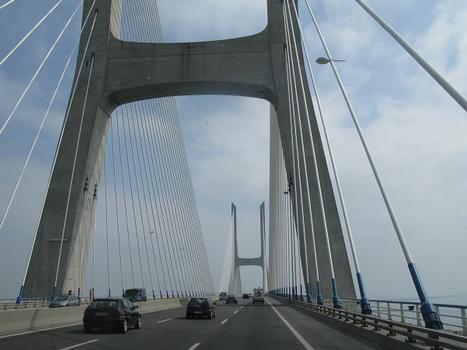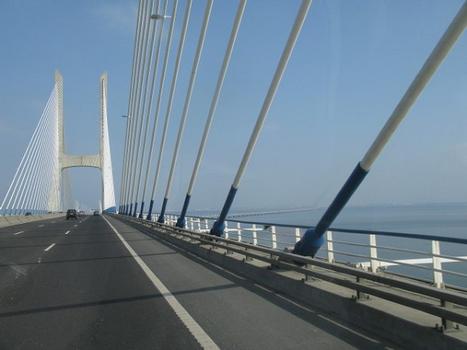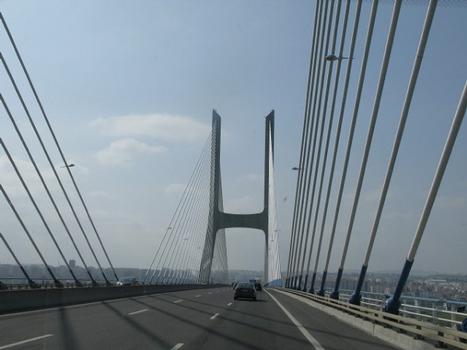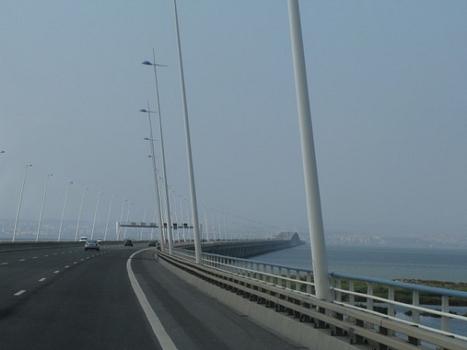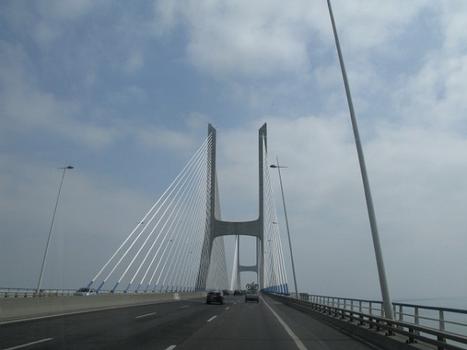General Information
| Name in local language: | Ponte Vasco da Gama |
|---|---|
| Beginning of works: | February 1995 |
| Completion: | 29 March 1998 |
| Status: | in use |
Project Type
| Structure: |
Cable-stayed bridge with semi-fan system Three-span cable-stayed bridge |
|---|---|
| Secondary structure(s): |
Structurae Plus/Pro - Subscribe Now! Structurae Plus/Pro - Subscribe Now! |
| Function / usage: |
Motorway bridge / freeway bridge |
| Material: |
Prestressed concrete bridge Structurae Plus/Pro - Subscribe Now! Structurae Plus/Pro - Subscribe Now! |
Location
| Location: |
Sacavem, Lisbon, Portugal |
|---|---|
| Crosses: |
|
| Part of: | |
| Coordinates: | 38° 43' 40.19" N 8° 59' 28.14" W |
| Coordinates: | 38° 47' 9.49" N 9° 6' 25.20" W |
Technical Information
Dimensions
| number of lanes | 2 x 3 | |
| overall length of crossing | 17 185 m | |
| overall length of structures | 12 345 m | |
| caissons | number | 81 |
| approach viaduct Expo (Parque das Nações) | ||
|---|---|---|
| total length | 672 m | |
| number of spans | 12 | |
| central viaduct | ||
| total length | 6 531 m | |
| number of spans | 84 m | |
| main bridge | ||
| main span | 420 m | |
| total length | 824 m | |
| number of cables | 192 | |
| vertical navigation clearance | 47 m | |
| deck | width | 30.9 m |
| pylons | pylon height | 155 m |
| northern approach viaduct | ||
| total length | 488 m | |
| number of spans | 11 | |
| southern approach viaduct | ||
| total length | 3 825 m | |
| number of spans | 84 | |
Quantities
| concrete volume | 730 000 m³ | |
| reinforcing steel | 100 000 t | |
| volume of earthworks | 1 400 000 m³ |
Materials
| deck |
prestressed concrete
|
|---|---|
| piers |
reinforced concrete
|
| pylons |
reinforced concrete
|
| abutments |
reinforced concrete
|
Case Studies and Applied Products
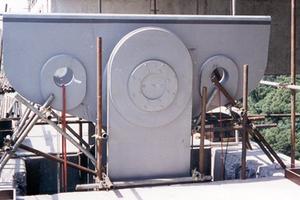
mageba Special Bearings
mageba has more than 40 years manufacturing know-how in the manufacturing of special bearings.
[more]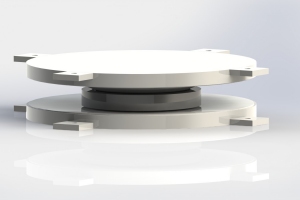
RESTON®PENDULUM – Seismic isolators
mageba seismic isolator RESTON-PENDULUM bearings are based on the functional principle of a pendulum. They allow a structure to become horizontally displaced during an earthquake, with seismic energy being dissipated by the friction betw ... [more]

RESTON®POT – Pot Bearings
mageba Pot Bearings are durable bearings that can be used in many situations, whether in big or small bridges, or a variety of engineering structures.
[more]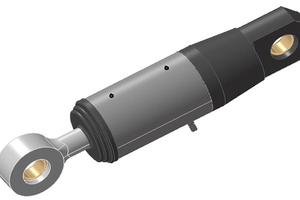
RESTON®SA – Hydraulic dampers
Under normal circumstances, Hydraulic Shock Absorbers allow free movements of the bridge structure. Under shock impact, e.g. due to earthquakes, high braking loads or strong winds, they function temporarily as elastic damping connections.
[more]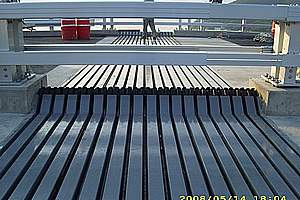
TENSA®MODULAR LR & LR-LS – Modular expansion joints
Modular Expansion Joints can be constructed for any movements, from about 100 mm up to 2,000 mm and more. They allow movements in all 3 directions and rotations around all 3 axes.
[more]Chronology
| 10 April 1997 | A metal falsework collapses killing six workers. |
|---|
Excerpt from Wikipedia
The Vasco da Gama Bridge (Portuguese:Ponte Vasco da Gama; pronounced [ˈpõt(ɨ) ˈvaʃku dɐ ˈɡɐmɐ]) is a cable-stayed bridge flanked by viaducts and rangeviews that spans the Tagus River in Parque das Nações in Lisbon, the capital of Portugal.
It is the longest bridge in Europe after the Crimean Bridge with a total length of 12.3 kilometres (7.6 mi), including 0.8 kilometres (0.50 mi) for the main bridge and 11.5 kilometres (7.1 mi) in viaducts. The Bridge is served by 4.8 kilometres (3.0 mi) of dedicated access roads. It was built to alleviate the congestion on Lisbon's 25 de Abril Bridge, and eliminate the need for traffic between the country's northern and southern regions to pass through the capital city.
Construction began on February 1995; the bridge was opened to traffic on 29 March 1998, just in time for Expo 98, the World's Fair that celebrated the 500th anniversary of the discovery by Vasco da Gama of the sea route from Europe to India.
Description
The bridge carries six road lanes, with a speed limit of 120 km/h (75 mph), the same as that on motorways, except on one section which is limited to 100 km/h (60 mph). On windy, rainy, and foggy days, the speed limit is reduced to 90 km/h (56 mph). The number of road lanes will be enlarged to eight when traffic reaches a daily average of 52,000.
Bridge and access road sections:
- North access roads: 945 m (3,100 ft)
- North viaduct: 488 m (1,601 ft)
- Expo viaduct: 672 m (2,205 ft); 12 sections
- Main bridge: main span: 420 m (1,378 ft); side spans: 203 m (666 ft) each (total length: 829 m or 2,720 ft); cement pillars: 150 m (492 ft)-high; free height for navigation in high tides: 45 m (148 ft);
- Central viaduct: 6.351 km (3.95 mi); 80 pre-fabricated sections 78 m (256 ft)-long; 81 pillars up to 95 m (312 ft)-deep; height from 14 m (46 ft) to 30 m (98 ft)
- South viaduct: 3.825 km (2.38 mi); 45 m (148 ft) sections; 84 sections; 85 pillars
- South access roads: 3.895 km (2.42 mi); includes the toll plaza (18 gates) and two service areas
Construction and cost
The $1.1 billion project was split in four parts, each built by a different company, and supervised by an independent consortium. There were up to 3,300 workers simultaneously on the project, which took 18 months of preparation and 18 months of construction. The financing is via a build-operate-transfer system by Lusoponte, a private consortium which receive the first 40 years of tolls of both Lisbon bridges. Lusoponte's capital is 50.4% from Portuguese companies, 24.8% French and 24.8% British.
The bridge has a life expectancy of 120 years, having been designed to withstand wind speeds of 250 km/h (155 mph) and hold up to an earthquake 4.5 times stronger than the historical 1755 Lisbon earthquake (estimated at 8.5–9.0 on the moment magnitude scale). The deepest foundation piles, up to 2.2 m (7.2 ft) in diameter, were driven down to 95 m (312 ft) under mean sea level. Environmental pressure throughout the project resulted in the left-bank viaducts being extended inland to preserve the marshes underneath, as well as the lamp posts throughout the bridge being tilted inwards so as not to cast light on the river below.
Toll
Northbound traffic (to Lisbon) is charged a toll, while traveling southbound is free. Tolls are collected through a toll plaza located in the south bank of Tagus, near Montijo. As of 2016, taxes range from €2.70 (passenger cars) to €11.70 (trucks).
Text imported from Wikipedia article "Vasco da Gama Bridge" and modified on 22 July 2019 under the CC-BY-SA 3.0 license.
Participants
- EEG Europe Etudes Gecti
- Armando Rito (designer)
- Charles Lavigne (architect)
- Michel Virlogeux (official expert)
- Bento Pedrodo Construções
- Campenon Bernard
- Edifer Construções
- Kvaerner Engineering & Construction
- Mota & Companhia
- Sociedade de Construções H. Hagen
- Somague - Sociedade de Construções
- Teixera Duarte Engenharia e Construções
Relevant Web Sites
Relevant Publications
- (2002): Bridges - Ponts - Brücken. Atrium, Mexico City (Mexico), pp. 342-347.
- : Conception parasismique du pont principal. Presented at: , pp. 189-208.
- (1998): La concession. Les arguments décisifs. In: Travaux, n. 743 (June 1998), pp. 21-32.
- (1998): La construction du Pont Vasco da Gama. In: Travaux, n. 743 (June 1998), pp. 18-20.
- : Consulting studies for the cable stayed Vasco da Gama bridge. Presented at: , pp. 209-222.
- About this
data sheet - Structure-ID
20000315 - Published on:
27/07/1999 - Last updated on:
30/10/2018



